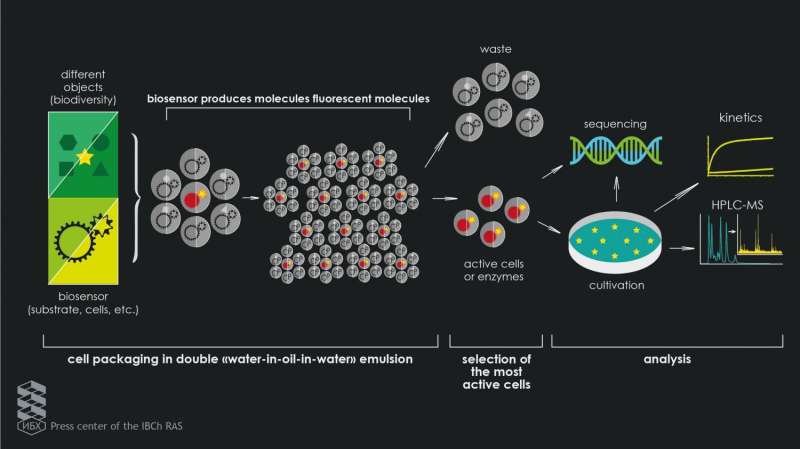Scientists develop cell-analysis method much faster than robotic workstations

Researchers at the Institute of Bioorganic Chemistry of the Russian Academy of Sciences have collaborated with colleagues from other research institutions and created a microfluidic system for ultra-high-performance screening in double emulsion droplets. This technique can be used when studying the unique properties of single living cells, and is 30,000 times more productive than robotic workstations. At the same time, it greatly simplifies the work of researchers involved in determining the functionality of biological objects for the creation of biomedicines. The results of this research were published in the PNAS journal.
"Researchers tend to spend a lot of their working hours testing, purifying and isolating highly active proteins. So we have tried to solve this problem by developing an ultra-high-performance screening system for isolating biomolecules based on microfluidic emulsions. The result is a system that allows us to isolate interesting biological functions from the enormous diversity of any microscopic biological object, not only enzymes," explains Stanislav Terekhov, junior researcher at the Russian Academy of Sciences, one of the authors of the article.
The idea came about three years ago, when Stanislav proposed developing a technology to quickly determine the activity of hundreds of millions of new enzymes produced by his colleague, Ivan Smirnov.This working group was engaged in creating and selecting biocatalysts from combinatorial libraries of enzymes that speed up reactions for which there are no natural enzymes. For example, for the inactivation of organophosphorus toxins, neuromuscular paralytic gases are relevant in connection with the growing use of pesticides and chemical warfare agents. The researchers had to spend years trying to obtain only a few dozen new proteins.
Using the photolithography method used to create computer chips, researchers from the Institute of Bioorganic Chemistry and collaborators created microfluidic chips with channels with a thickness smaller than the diameter of a hair to generate emulsion droplets. The researchers used droplets of water-oil-water double emulsion to isolate single cells, allowing them to study their unique properties. Using microfluidic chips, Stanislav and his colleagues put the individual living cells into the droplets, after which the enzymatic and biological activity of the cells in the drops was studied using a fluorescence-activated cell sorter. The fluorescence drops helped detect the most active cells. The isolated cells in the drops were then further analyzed using classical molecular-biological methods and modern metabolic methods of analysis, as well as large-scale sequencing based on the Federal Clinical Research Centre's physical and chemical medicine.
"As a result, we were able to obtain approximately 108 drops per hour, and in a day, we managed to isolate the necessary amount of enzymes with the required amount of activity," says Stanislav. "For example, we managed to improve the enzyme butyrylcholinesterase, which not only linked the organophosphorus toxin, but helped it to hydrolyze it, and link to the next toxin. Afterwards, we encapsulated bacterial cells in order to trace which microorganisms are inhibitors of the growth of the highly pathogenic bacteria Staphylococcus aureus. Thus, our screening method is suitable for discovering new drugs that are enzyme-based or based on microorganisms, their metabolites and other biological objects."
This universal microfluidic screening platform that the researchers have developed requires significantly less time and financial resources.
More information: Stanislav S. Terekhov et al. Microfluidic droplet platform for ultrahigh-throughput single-cell screening of biodiversity, Proceedings of the National Academy of Sciences (2017). DOI: 10.1073/pnas.1621226114
Journal information: Proceedings of the National Academy of Sciences


















